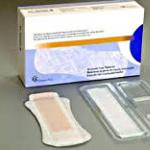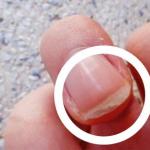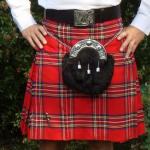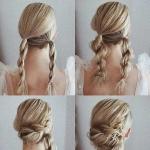Density of jacquard fabric. Luxurious jacquard patterns
Just a couple of decades ago, when mentioning jacquard fabric, the average person would associate it with a jacquard bedspread or expensive curtains. Now there are so many types of jacquard that one can doubt what jacquard fabric really is? Let's figure it out.
Jacquard first appeared in France, thanks to the inventor Joseph Jacquard, in 1801. He invented a special loom on which it was possible to produce fabric with large, complex colored patterns. Since then, the material has been produced on an industrial scale. Punch cards were already used in the machine back then!
Description
The relief pattern is noble and refined. Fabric threads can be used different materials: natural, synthetic or mixed. The spectacular appearance of the product also depends on the lighting: the fabric shimmers, and silk jacquard looks especially beautiful. The invention was appreciated during the life of the innovator by Napoleon himself (a connoisseur of beautiful fabrics and more), who assigned a pension of 3,000 francs. And for each new machine that appeared in the country, the inventor was entitled to a bonus of 50 francs. And in the city of Lyon there is even a monument to Jacquard.
Jacquard is not the composition of the fabric, not the material of the fibers, but the method of weaving them. Both natural and artificial fabrics can be jacquard.
Bed linen, table linen, blackout curtains, clothing, furniture covers are made from jacquard. It is also used for upholstery of upholstered furniture. Natural fabrics are more expensive. And if synthetic fiber is added to the thread composition of cotton fiber, then the fabric will be cheaper in price and at the same time stronger. Find out about what fabric to choose for upholstering a sofa.
A distinctive feature of jacquard is its woven, regularly repeating pattern.
Advantages and disadvantages
The advantages of jacquard largely depend on its composition, but general characteristics can be identified:
- Spectacular appearance.
- Strength. Density (250g/m). When making textiles, the threads, intertwined, are also twisted, which is why the material is very durable.
- Resistance to deformation (does not stretch, does not stretch).
- Pleasant texture to the touch.
- Easy to care for.
The only drawback can be the high price, especially for jacquard made from natural materials.
Jacquard is a strong, wear-resistant material (after all, the threads do not break under mechanical stress), durable (the pattern does not wear out, the color does not fade).
Types of jacquard
The material can be divided into types, depending on the composition of the threads:
- Jacquard-satin. Such a canvas does not have a clearly defined reverse side: a convex pattern on one side will be depressed on the other. If two colors were used for the fabric, for example, light green and dark green, then on one side the dark green pattern will be printed on a light green background, and on the other side, on the contrary, the light green pattern will be on a dark background. There is one pattern, but the colors of the pattern and background are “swapped” (double-sided jacquard). Bed linen is often made from jacquard-satin. It is considered elite. After all natural cotton very comfortable to use: pleasant to the touch, absorbs moisture well, and the exquisite pattern on the silky surface looks very stylish and rich.

It looks like a tapestry. Interesting texture with a relief woven pattern.
- Jacquard satin. From the beginning it was made from silk threads, thanks to which the canvas shone. And later, instead of silk, artificial fibers are used. Lightweight material in weight, almost wrinkle-free, affordable. Bed covers and curtains are often made from this material. The complex interweaving of threads with unequal pitches gives an interesting texture. The colors seem to shimmer, and this makes jacquard satin products elegant and solemn. Find out what fabric to make a bedspread from by following the link.

The surface of the fabric is smooth to the touch and shiny in appearance.
- Stretch jacquard– highly elastic material, which includes elastic synthetic fibers– lycra, spandex, elastane. The fabric allows air to pass through well.

Products made from it fit perfectly to the figure, which is why the fabric is used mainly for sewing clothes.
- Jacquard knitwear– most often these are warm knitted winter clothes, jumpers, dresses, scarves, gloves, mittens, hats, as well as hosiery.
- Jacquard-silk It can be natural (quite an expensive product) or artificial. Used for sewing bed linen, negligees, and sometimes clothes.
- Organza can also be jacquard. Most often, curtains are made from jacquard organza. It is also used for gift packaging(gift bags).

Organza is a relief pattern woven on the finest fabric. Such magnificence looks very elegant.
Jacquard is a popular upholstery material. For upholstery I produce several types, differing in density and thickness:
- Single layer;
- Two-layer (backed with foam rubber on the inside);
- Three-layer – tripled (lining, foam, front layer). This material is popular in the automotive industry: car covers are made from it.
Color variety of jacquard
There are two ways to dye jacquard:
- The threads are initially dyed, from which the fabric is then woven.
- Printing is applied to the finished fabric.
The color of jacquard fabric can be single or multi-colored. Plain fabric looks restrained. Often two tones are used, one for the main background, and the other color emphasizes the woven pattern. This canvas looks very noble. Pure white jacquard is also often found: mattresses are made from it. The wear resistance and practicality of the material is ideal for these products. White jacquard is also chosen for sewing stage costumes or, for example, for the Snow Maiden costume. They also sew clothes from white jacquard.

Suits and dresses look rich and solemn, so most often these are clothes for going out, for a special occasion.
Some characteristics of jacquard are similar to those of eco-leather: wear resistance, pleasant tactile sensations, and both are “breathable” materials. Both materials, just like nubuck, are often used for upholstery of furniture, car interiors, and the manufacture of women's cosmetic bags and bags. But these fabrics are made differently, they have completely different compositions, and in appearance they are completely different, and here you just need to choose what you like best.
How much does jacquard cost?
Fabric prices depend on its composition. As a rule, the more natural fibers, the more expensive. Cheaper in price - synthetics. And the price per meter depends on the manufacturer. Now on the Russian market there are a lot of jacquard fabrics made in China. They attract buyers primarily due to their affordable price. The quality can be found to be quite acceptable, and the price is justified by cheap labor, the use of mixed or only synthetic fibers.
There are also jacquard products of joint production, when, for example, a serious Italian company sews them in China. In this case, the quality will be high, but the price will be more expensive than Chinese items, but cheaper than Italian ones.
Better than Chinese ones are Turkish fabrics. They contain more natural raw materials (often 100% cotton) and the products are made of better quality.
Expensive and high-quality jacquard fabrics made in Europe. The same are the products made from them. The price is justified by the composition; for example, Portuguese manufacturers often choose the best Egyptian cotton for jacquard.
Relatively inexpensive and fairly high-quality Russian jacquard (manufactured in Ivanovo).
The range of jacquard fabric, the distinctive feature of which is a relief pattern, is huge. Jacquard is used to make bedspreads, curtains, covers, canopies, clothes, bags, and ties. Upholstery of upholstered furniture made of jacquard, in comparison with other fabrics for upholstered furniture, is very practical and looks rich and solemn. Quality characteristics depend on the composition of the fibers. They choose, of course, according to their intended purpose. And the choice of composition and manufacturer depends on financial capabilities and individual preferences.
Jacquard is a fabric creation technique in which, using special machines, threads are directed according to a specific pattern, often large and intricate. This is the main difference between fabric and printed materials: the pattern is not applied to the finished fabric, but is gradually woven from colored or plain threads.
Description, types of weave
The threads for the fabric are first dyed, then using a special technology they are woven into fabric. The rapport of such large-patterned fabric contains at least 45 warp threads. Jacquard is strikingly different from other materials with its rich, jewelry appearance. It is double-sided: the ornament runs along the entire length of the canvas from the front and back sides. Due to the complex production technology, the cut is expensive.
Jacquard fabrics are embossed, rough, and the pattern on them is very clear. It is woven in multi-colored, monochrome or the same tone as the background. The ornament depends on the method of weaving: usually these are floral elements, geometric, oriental designs.

Jacquard weave is divided into regular and complex:
- In the conventional method, only one system of warp threads and one system of weft threads are used.
- For multi-layer and multi-color fabrics, a complex weaving method is used, with several warp and weft systems. This is how two-layer, double-sided, pile jacquards are produced.
Composition and properties
The main properties of all jacquard fabrics:
- durable due to complex weaving and twisting of threads;
- quite light, despite the density;
- wear-resistant, tolerates washing well;
- retain color brightness for a long time;
- do not stretch and keep their shape well;
- pleasant to the touch;
- look luxurious.

Some properties of jacquard also depend on the raw materials:
- Natural fibers- wool, cotton, linen, silk. These are hypoallergenic materials that are pleasant to the body.
- Synthetic jacquard woven from polyester and polypropylene. Costs less natural fabric, while also being quite durable and wear-resistant. However, it is stuffy and poorly suited for clothing, but excellent as upholstery, tablecloth, etc. textiles
- Mixed option- optimal in terms of price and quality ratio.
Examples of jacquard fabrics and their applications
Some types of jacquard fabrics and their use:
- Popular fabric is made from cotton - jacquard satin. Bedding sets and wardrobe items are made from it. Jacquard satin consists of two colors. On one side the pattern will be convex, on the other it will be depressed. The colors also change depending on the placement of the fabric.
- Delicate, light, tender and often expensive fabric. Used to create luxury lingerie, bedding sets.
- - shiny, iridescent and very smooth material made of synthetic fibers. Such fabrics are used for making curtains, bedspreads, and covers.

Other areas of application of jacquard: car covers, upholstery for mattresses, furniture. The inclusion of synthetics in the fabric allows you to sew elastic, tight-fitting items. Jacquard fabrics are used both for the finest products and for warm winter clothes. All this allows us to consider the type of fabric universal, despite its sophistication.
Care
Jacquard products are usually very durable and can withstand many washes. But the type of care depends not only on the method of weaving the threads, but also on their composition. Thus, thin jacquard organza requires delicate handling.

Generally, textured fabrics are washed in warm or cold water at medium and low speeds. It is not recommended to use aggressive cleaning products. It is better to dry jacquard away from sunlight in a straightened form. Fabric with an ornament should be ironed from the inside out. With proper care in accordance with the recommendations on the label, the jacquard will last for many years.
A look into the past
At the beginning of the 19th century, a special loom was invented in France. It made it possible to direct the threads in a complex pattern to create a large pattern along the length of the entire material. The author of the idea was Joseph Jacquard. Modern matter bears the name of this hereditary weaver and inventor. It is interesting that modern weaving technologies are not much different from the technologies of the century before last. It is not for nothing that for his ingenious invention the master was awarded a lifelong pension and a monument at the behest of Emperor Napoleon I.

Jacquard products were originally the privilege of the nobility. Today, affordable products are made from canvas: clothing, covers and upholstery for furniture, etc.
The fabric market is rich in various jacquard fabrics. You can choose any jacquard product, be it an everyday item or clothing for a celebration, bed linen or home textiles. The variety of patterns and the use of natural and synthetic fibers make elegant jacquard accessible to any wallet.
Ornaments on fabric have been created since ancient times. Today, the ancient traditions of tapestry making are still used, in which the woven pattern is created almost by hand. This article provides information about such material as jacquard. What kind of fabric? What are the main features of this weaving?
What are they made from?
Jacquard is a complex type of weave rather than a specific material. Jacquard fabric was always made from cotton, linen, silk or regular animal wool. Products from similar materials are still produced today, but in most examples synthetics are used.
The tapestry is considered one of the most striking examples of the use of jacquard fabric.
Fabrics are also produced on which the ornament appears after being passed through a thermal printing machine. At its core, it is not jacquard. Traditionally, the pattern on canvases is woven with threads and looks much more beautiful. In addition, under certain lighting an additional decorative effect appears.
Natural materials are valued much higher on the market than synthetic materials.
Types of jacquard fabric
Let's look at the main types of jacquard fabric:
- Cotton jacquard. The composition of this fabric includes cotton with a small synthetic content. Depending on the texture of the material and thickness, it can be used in the manufacture of upholstery for furniture, decorative textiles, or clothing;
- Satin jacquard. This is the material that is used to produce jacquard bed linen;
- Stretch jacquard. Synthetic elastic fibers are added to this material. Such fabrics stretch and breathe well and are used in most cases for wardrobe items and orthopedic mattresses;
- Polyester-based satin-jacquard is a wonderful option for making curtains and decorative textiles. Such products do not require washing, do not wrinkle, do not shrink, and do not require care;
- Furniture jacquard is used for upholstery of sofas and armchairs. Thanks to modern technologies, furniture fabrics can be duplicated with foam rubber;
- Organza woven using jacquard weaving is used to sew beautiful curtains or other decorative items. On thin fabric large relief ornaments clearly appear;
- Jacquard knitted fabric is knitted from loops at small intervals. Density is determined by the quantity, as well as the nature of the threads used;
- Silk jacquard is the lightest elegant fabric made from artificial or natural fibers. It produces very high-quality underwear, bed linen, and clothing for holidays.
Purpose
The purpose and main properties of jacquard fabric are determined by several main characteristics:
- Thin linens with natural fibers are primarily used in the manufacture of bed linen and beautiful exclusive clothing;
- High-density synthetic jacquard is used for curtains and as a decorative material;
- Fabrics with maximum density and special impregnation are often used for furniture upholstery.
Advantages and disadvantages
The advantages of jacquard fabric are always determined by its composition. However, general characteristics should be highlighted;
- Effective visual qualities;
- Strength. High density up to 250 g/m. When such fabric is produced, the fibers are not only intertwined, but also twisted. This gives the jacquard greater strength;
- Resistance to various deformations. The material does not stretch or shrink;
- Pleasant tactile sensations;
- Easy to care for.
The only disadvantage is the high cost. This especially applies to jacquard made from natural fibers.
Materials with jacquard weaving are strong, wear-resistant and durable.
Types of weave
Today, all jacquard fabrics are made on high-quality CNC machines. The pattern on the canvas can be repeated or stretched to its full width.
Types of jacquard weaving:
- Simple. They are formed from one system of threads used for the warp and the second for the weft, which are intertwined using the usual derivative and mixed weave methods. Using similar methods, satin jacquard, crepe de Chine, marshmallow and others are made from wool, silk or cotton. beautiful fabrics. Napkins, tablecloths, and other home textile products are made from flax.
- In complex jacquard weaves, there is more than one fiber system for warp and weft. As a result, it is possible to obtain multi-layered fabrics with beautiful multi-colored patterns.
Complex jacquard weaves include:
- Double-sided, from which costumes are made;
- Two-layer for making tapestries;
- Pile fabrics are used as furniture fabrics.
Classic types of jacquard weaving are systematically improved. Modern technical devices can work with wide range a variety of natural and synthetic materials.
Coloring methods
Jacquard immediately becomes more elegant thanks to its texture. Bleached fabric is often used. White jacquard is used to make mattress covers and beautiful designer suits.
Painting in progress different ways. Sometimes the threads are dyed and then installed in the loom. Other technologies make it possible to dye finished canvases.
Jacquard fabric can be either plain or multi-colored. Plain color has a more discreet appearance. Two basic tones are often used. One is used for the background and the other for the woven design. Such paintings look very noble. Pure white jacquard is often used.
Practicality and wear resistance are the main properties of jacquard bed linen.
The properties of some jacquard fabrics are somewhat reminiscent of eco-leather, which is also characterized by high wear resistance and pleasant tactile sensations. These two types of materials allow air to pass through well. Also, these two types of fabric are used for upholstery of furniture, car seats, women's cosmetic bags, handbags and other accessories. However, eco-leather and jacquard fabric are made in different ways.
Price
The cost of jacquard fabric depends on the composition. Natural fibers in the weave increase the cost. Synthetics, of course, will be cheaper. Also, the cost of a linear meter is determined by the brand that produces it.
- Available in Russia today a large number of Chinese paintings. Many people prefer them due to their high cost. The quality of such materials is optimal, and the cost is determined by the relatively inexpensive labor force, as well as the composition.
There are many co-produced jacquard fabrics. Many famous Italian brands are transferring production to China. The quality of the materials remains high, but their cost is slightly higher, but still inferior to jacquard weaving made in Italy.
- Turkish materials are much better than Chinese ones. They contain a large amount of natural raw materials, often using 100% cotton;
- European-made jacquard fabric is distinguished by its high cost and quality;
- Affordable and high-quality Russian jacquard is produced in Ivanovo. This is Ivanovo bed linen, famous not throughout the country.
When choosing jacquard fabric made from natural fibers, it is better to give preference to Russian and European manufacturers.
The range of jacquard fabrics is truly huge. The following materials are used to produce:
- Curtains;
- Cases;
- Clothes;
- Canopies;
- Bed sheets;
- Bags;
- Ties.
Jacquard upholstery for upholstered furniture is practical. Quality is determined depending on the composition of the fibers. Materials are selected in accordance with the purpose of the products from which they are made. Financial capabilities determine the choice of composition and brand.
How to care?
Due to their high strength, jacquard fabrics are not too demanding to care for. However, if you want to preserve the original visual characteristics of the product, you need to adhere to several basic recommendations:
- You should always follow the manufacturer's care instructions on the attached label;
- Machine spinning is not suitable for jacquard bed linen;
- It is not advisable to dry jacquard bed linen in the open sun;
- It is permissible to iron fabrics only from the wrong side;
- There is no need to use special detergents for washing jacquard bed linen.
When choosing curtains or a bedspread from curtain fabric, you need to understand that the ornament is in classic style will always be relevant, and the sophistication of the colors will delight you for a very long time.
Now no one will have any questions about what kind of jacquard fabric it is.
The machine for the production of fabric with relief weaving was created by a weaver from Lyon, Joseph Marie Jacquard, and the material was named after him. What kind of fabric is this - jacquard? Smooth and pleasant to the touch fabric, which is obtained thanks to a special weave of threads. To create a pattern, threads of different shades are used; in some cases, the pattern is applied later, when the fabric has already been woven.
Description
Jacquard is not cheap due to the complexity of the production process. main feature woven patterns - there is a very large number of threads per unit surface, which determines the specific properties of the material.
Fabric description:
- a distinct pattern, often three-dimensional;
- attractive appearance;
- crease resistance;
- ease.
The composition of jacquard includes artificial or natural fibers, as well as their combination. How much the fabric will weigh depends on the thickness of the fibers that make up it and on the number of shades that form the pattern. The two-color material, despite its high density, is lightweight and easy to care for. Usually the number of multi-colored threads reaches ten to create a complex pattern - 100 or more.
Advantages and disadvantages
Jacquard fabric has only one drawback - high cost. At the same time, fabric made from natural fibers is more expensive than synthetic ones.

Advantages:
- increased strength;
- high wear resistance;
- resistance to temperature changes;
- ease of care.
Kinds
Jacquard fabrics come in several varieties, the most common are:
- - it contains cotton, often mixed with synthetic fibers. The thickness and texture can be different, depending on them, decorative textiles, upholstery materials, and clothing items are made from cotton jacquard.
- - used as raw material for sewing luxury bed linen. Satin jacquard is made on a cotton base with the addition of synthetic threads.
- Stretch is a jacquard, which contains elastic synthetic threads, the material has excellent stretch and breathability. The fabric is used for sewing clothes and making orthopedic mattresses.
- Satin jacquard made from synthetic polyester fibers. Serves as an ideal raw material for sewing curtains and various decorative textiles. The fabrics do not wrinkle, do not shrink when washed, and are easy to care for.
- Jacquard knitwear used as raw material for sewing warm clothes: sweaters, coats, blouses, suits, dresses, skirts.

Technical characteristics and composition determine the properties and purpose of jacquard fabrics:
- fine fabric made from natural fibers, used for sewing high-quality clothing and bed linen;
- jacquard based on synthetic fibers, characterized by high density, is used as curtains, curtains and decorative material;
- For upholstery, the densest type of jacquard is used, with a special impregnation, which is necessary to facilitate the care of furniture.
Compound
Jacquard fabric comes in several varieties: synthetic, silk, blended and cotton.
All types differ from each other in composition:
- Synthetic jacquard fabric contains polypropylene and polyester, is characterized by a long service life, does not require special care, and is pleasant to the touch. Synthetic jacquard is often used to make household products, such as mattresses.
- is the most expensive of all the varieties presented. It is environmentally friendly and does not cause allergies.
- Blended fabric is much cheaper than cotton or silk jacquard. The increased density and other advantages of mixed fabric are due to the content of non-woven fibers. The most popular is stretch jacquard, which is a highly elastic, breathable fabric.

How to choose
First of all, consumers choose jacquard according to its intended purpose. The criteria of price and brand are not of great importance and depend on the personal preferences of the buyer, as well as financial capabilities.
The range of materials, the distinctive feature of which is a relief pattern, is truly huge. Jacquard is used to make bedspreads, covers, canopies, bags, ties and other items of clothing, and curtains. Appearance sofas covered with such material are distinguished by their beauty and at the same time such upholstery is very practical. Jacquard table linen (tablecloths, napkins) looks very rich and solemn, and how high quality it will be depends on the composition of the fabric.
Advice! How much jacquard material will cost is determined by its composition: the more fibers of natural origin it contains, the more expensive the fabric. The price per meter also depends on the manufacturer.
Currently, the Russian market is filled with jacquard from Chinese manufacturers, which is distinguished by its low cost, while the quality can be very acceptable. Chinese-made jacquard is most often represented by synthetic or mixed material.

Sometimes there are paintings of joint production. For example, a serious Italian company with a good reputation produces jacquard in China. We can say that such cooperation provides a low price (lower than for Italian products) with very good quality.
Turkish jacquard is considered better than Chinese jacquard, since it contains more raw materials of natural origin, and the products are of higher quality.
They are distinguished by the highest quality fabric from European manufacturers, but at the same time they are very expensive. This fabric contains the best raw materials; for example, manufacturers from Portugal add the best to jacquard.
Domestic jacquard is of relatively high quality and inexpensive, produced in Ivanovo.
Care
It is better not to clean an expensive, exclusive product from stains and dirt yourself, but to entrust it to dry cleaning. Jacquard of low and medium quality will not be damaged if you wash it at home. This should only be done after carefully studying the manufacturer's recommendations on the label.
 Jacquard fabric, art.
Jacquard fabric, art. Rules for caring for jacquard:
- fabrics painted in bright shades are contraindicated in direct sunlight and elevated temperatures;
- for washing, use high quality detergent without bleaching or other special additives;
- the formation of creases during storage and drying of jacquard products should not be allowed;
- such items must be washed at a temperature no higher than 30˚ C;
- the stain formed on the surface of the fabric should be removed carefully, without applying significant effort, in order to avoid damaging the structure of the material;
- Jacquard products must be spun in a centrifuge after washing and rinsing;
- Ironing of fabric is carried out from the wrong side.
The technique of creating woven ornaments has been known since ancient times. To this day, a description of the ancient traditions of creating tapestries has been preserved, in which the woven pattern is created by hand.
Jacquard is a fabric that recreates the ornament and texture of tapestries, but at the same time created in an industrial way.
Most often, such material has a complex but repeating pattern, although exclusive fabrics may also have a single unique design, for example, a monogram or logo.
Who came up with this?
The idea of creating a machine for the production of embossed patterned weaving of fibers belongs to the hereditary Lyon weaver Joseph Marie Jacquard. It was he who guessed to change the positions of the threads in the loom using cardboard cards with drilled holes, and the sequence of these cards (sometimes up to a thousand) created a given pattern, visible on both sides of the fabric.
For such an invention in 1891, Jacquard was generously awarded by Emperor Napoleon, a monument was erected to him - and at the same time, the spread of machines for the production of jacquard led to unemployment among Lyon weavers and their uprising, which was described in history books. However, to this day, the technical methods of operating such a machine remain the same, and its productivity is low - only instead of cards with holes, computer programs are used.
What are the benefits of woven ornaments?
The main technical characteristic of woven patterns is the maximum thread density per unit surface. As a result, jacquard fabric has the following properties that make it very attractive to use:
- Very high strength and density.
- Durability.
- Easy care.
- Beautiful appearance.

The weight of the fabric depends on the thickness of the fiber included in its composition and the number of its shades that form the pattern. Two-color jacquard with a high density is quite light and easy to care for.
The number of threads of different colors can reach ten, and a hundred or more threads are used to form a complex pattern.
Thin jacquard fabric, which is easy to wash and iron, is used for clothing, table linen, bed linen, and curtains.
Thick jacquard is used to make bedspreads, covers, and used for upholstery. Furniture material is often treated with special impregnations that improve its technical characteristics, in particular, repelling dirt and water. Curtains made using special dim-out technology do not allow light to pass through. For this purpose, they have an internal light-proof layer, which is woven with decorative fibers.
What is jacquard made from?
Ancient jacquard fabric was made from cotton, linen, silk, and wool. Such materials are still produced, but in most cases the composition of modern jacquard fabric contains synthetics (in whole or in part).
In inexpensive synthetic fabrics The ornament is formed not by weaving colored threads, but by thermal printing. However, the traditional woven pattern looks much more beautiful, and the light creates an additional decorative effect on the surface of the material.
Although natural fibers are usually valued much higher than artificial ones, the addition of elastane or lycra fibers to this elegant material gives it properties such as easy care, elasticity and breathability.
Types and purpose of fabric
The most common types of jacquard are:
- - jacquard, which contains cotton, often with the addition of synthetic fibers. Depending on the thickness and texture, it is used for clothing, decorative textiles, and upholstery materials;
- satin - jacquard (cotton-based, sometimes with a small addition of synthetics), which is used mainly for sewing luxury bed linen;
- stretch - jacquard, to which elastic synthetic fibers are added. This fabric stretches well, allows air to pass through, and is used mainly for clothing and orthopedic mattresses;
- satin-jacquard made of polyester is an ideal material for curtains and decorative textiles; this fabric does not require washing, does not wrinkle, does not shrink, and is very easy to care for.
The purpose and properties of jacquard fabrics are determined by two parameters - technical characteristics and composition:
- Thin material based on natural fibers is used primarily for exclusive clothing and bed linen.
- Synthetic jacquard, which has a high density, is used for curtains and as a decorative material.
- The densest fabric, often with special impregnation that makes it easier to care for, is used for upholstery.
How to preserve the beauty of woven patterns?

If you are lucky enough to become the owner of an exclusive item made of expensive jacquard, then it is better to entrust its care to dry cleaning specialists. Fabrics of the middle and low price segment, as a rule, do not lose their properties if they are washed and cleaned at home (after studying the description of what they are made of). You just need to remember a few simple rules:
- colored jacquard is contraindicated in direct sunlight and high temperatures;
- When drying and storing jacquard fabrics, creases should be avoided;
- When cleaning a stain on the surface, you should not apply much force so as not to disturb the structure of the fabric;
- when washing, it is advisable to use low-temperature mode and high-quality powder without bleach and other special additives;
- spinning should be done in a centrifuge;
- Jacquard fabrics must be ironed from the inside out.






